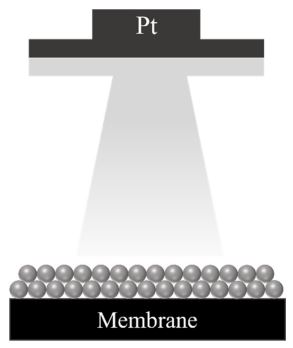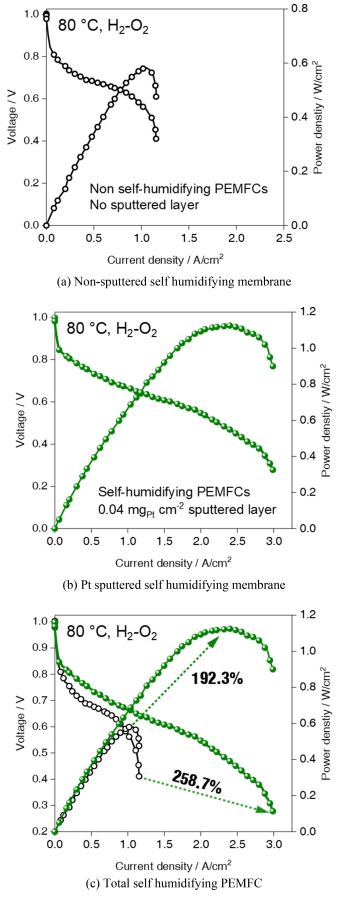
이오노머 코팅층을 추가한 자가 가습 고분자 전해질막 연료전지

Copyright © The Korean Society for Precision Engineering
This is an Open-Access article distributed under the terms of the Creative Commons Attribution Non-Commercial License (http://creativecommons.org/licenses/by-nc/3.0) which permits unrestricted non-commercial use, distribution, and reproduction in any medium, provided the original work is properly cited.
Abstract
In this study, we aim to develop a self-humidifying polymer electrolyte membrane fuel cell (PEMFC) by depositing platinum (Pt) on a membrane using sputtering. After we coated it with a Nafion® ionomer solution. This is considered a solution that can prevent membrane degradation in low humidity conditions. By introducing this self-humidifying concept, we can expect improved performance compared to conventional PEMFCs. By managing the water content of Nafion®, we aim to improve both the stability and performance of the PEMFCs. This research contributes to the development of more efficient and reliable PEMFC systems, showing promise for advances in this field.
Keywords:
Self-humidifying, Polymer electrolyte membrane fuel cell, Low-humidity, Deposition키워드:
자가 가습, 고분자 전해질막 연료전지, 저습, 증착1. 서론
고분자 전해질막 연료전지(Polymer Electrolyte Membrane Fuel Cell, PEMFC) 기술은 화학 에너지를 효율적으로 전기 에너지로 변환시키는 친환경적인 기술로서[1,2], 이동식 전원으로의 확장 가능성이 크게 증가하고 있다[3,4]. PEMFC의 핵심 구성 요소인 전해질막은 연료전지의 성능과 안정성에 결정적인 영향을 미치는 중요한 요소이다.
연료전지 작동 시 충분한 수분 공급을 위해 설치되는 가습 장치는 연료전지 시스템 효율을 낮추는 문제를 야기한다. 이러한 이유로, 현재 연구 동향은 가습 장치를 배제한 방향으로 발전하고 있다[5].
전해질막은 우수한 양성자 전도성과 화학 안정성을 제공하지만, 연료전지 작동 중 수분 함량의 변화에 민감하게 반응한다. 특히, 저습 조건에서 전해질막의 수분 손실은 성능 하락과 내구성 감소를 야기할 수 있다. 이러한 문제를 해결하기 위해 자가 가습 기능을 갖춘 전해질막의 개발은 PEMFC의 안정성과 성능 향상을 위한 중요한 연구주제로 강조되고 있다[6-8].
Aylin Rahnavar 등의 연구에 따르면 이오노머는 뛰어난 수분 흡수 능력을 가지고 있어, 전해질막 내부의 수분 분포를 관리하고 안정한 양성자의 전도성을 유지하는데 도움이 된다. 따라서 우리는 이오노머를 이용하여 자가 가습이 가능한 전해질막을 제작하였다[9-12]. 또한, 스퍼터링 기술을 이용하여 전해질막과 이오노머 사이에서 반응을 유도하여 수분 공급을 원활하게 하였다. 이렇게 제작된 전해질막은 낮은 상대습도에서 성능 평가를 통해 자가 가습 효과의 효용성을 확인하였다.
2. 실험 준비
2.1 백금 스퍼터링(Sputtering) 증착
Fig. 1(a)에서 나타난 대로, 백금 타겟(99.99 wt%, RND Korea, Republic of Korea)을 마그네트론 스퍼터링(Magnetron Sputtering)기법을 사용하여 Nafion® 211에 증착하였다. 스퍼터링에는 직류(DC) 전력 발생기(적용 전력 30 W)가 사용되었다. 챔버의 작업 압력은 90 mTorr이며, He와 Ar의 유량은 각각 25 sccm이다. 이때, 챔버의 높은 압력과 He 가스의 사용으로 플라즈마의 자유 경로가 짧아져 백금 입자 크기가 작아진다[13,14]. 백금 증착량은 0.04 mg/cm2이다.
2.2 MEA (Membrane Electrolyte Assembly) 제작
Fig. 2(a)는 자가 가습 전해질막의 구성 요소이다. 백금 스퍼터링된 전해질막에 25.4 μm 두께로 Nafion® 이오노머 용액 500 μL (5.0 wt%; Sigma-Aldrich, United States), 이소프로필 알코올(Isopropyl Alcohol) 750 μL (Daejung Chemical Co., Republic of Korea)의 혼합 용액을 분사했다. 비 자가 가습 전해질막의 경우 진공 챔버 안에서 백금 증착을 하지 않고, 열화만 시킨 후 그 위에 혼합액을 분사하여 Nafion® 211의 두께와 같은 층을 만들었다. 마지막으로, Nafion® 이오노머 용액, 이소프로필 알코올, 증류수와 함께 탄소 지지 백금(Pt/C, 40 wt%; Alfa Aesar, United States)을 혼합한 촉매 잉크를 30분 동안 초음파 처리하여 양극 및 음극 표면에 분사했다. 양극 및 음극의 백금 증착량은 0.12 mg/cm2이고, 각 활성 영역은 5.0 cm2의 정사각형 모양이다. 이후, 기체확산층(Gas Diffusion Layer, Sigracet 36BB, SGL carbon, Germany)과 Teflon 가스켓240 μm이 양극에 대칭적으로 삽입되었다. 기체 확산층은 수분 관리를 위해 폴리테트라플루오로에틸렌(Polytetrafluoroethylene) 처리된 기체확산지지체(Gas Diffusion Backing Layer) 및 미세다공층(Micro Porous Layer)으로 구성되었다. 이러한 과정을 통해 제작된 MEA는 Fig. 2(b)에 나타난다.
2.3 PEMFC 구성
양극과 음극 양쪽의 분리판은 그라파이트로 만들어진 단일 채널 사형 구조의 유동장을 가지며, 두께는 10 mm이다. 유동채널의 리브(Rib)와 너비는 각각 0.5 mm로 설정했다. 전류 집전체는 2 mm 두께의 황동에 금 도금 처리를 하여 만들어졌으며, 연료전지 반응에서 생성된 전자를 효과적으로 전달하기 위해 설계되었다. 엔드 플레이트(End Plate)는 알루미늄 재질로 만들어졌으며, 전기 절연을 위해 아노다이징(Anodizing) 공정이 수행되었다. 각각 8개의 구멍이 있어 볼트와 너트를 고정하며, 반응물과 생성물의 효과적인 분배를 통해 연료전지 내에서 효율적인 전기 화학 반응이 가능하도록 한다.
2.4 PEMFC 특성
제작된 MEA는 단위 셀에 조립되었다. 실험은 80oC의 셀 온도에서 30%의 상대습도로 수소와 산소 기체를 각각 음극과 양극으로 공급하였다. H2/O2는 0.15/0.3 sccm의 비율로 공급되었다. 또한 음극에는 1 barg, 양극에는 1.5 barg의 역압(Back Pressure)이 주어졌다. 연료전지의 성능을 평가하기 전에 MEA의 안정적인 운전을 위해 상대습도 30% 환경에서 30분간 활성화를 진행하였다. 자가 가습 PEMFC와 비 자가 가습 PEMFC는 동일한 실험 조건에서 작동하였다.
MEA의 성능 특성을 파악하기 위해 전류 밀도 전압(j-V) 분극 곡선을 측정하였다. j-V 분극 곡선은 OCV (Open Circuit Voltage)로부터 셀 전압이 0.3 V(표준 전극 전위)까지 갈바노다이나믹(Galvanodynamic) 모드를 사용하여 40 mA/s의 속도로 측정되었으며, 이를 위해 PEMFC의 시험 장치(CNL Energy Inc., Republic of Korea)를 사용하였다. 또한 PEMFC 전해질막의 Pt 박막층의 표면 미세 구조는 전계 방출형 주사 전자 현미경(Field Emission-Scanning Electron Microscope, FE-SEM)을 사용하여 분석되었다.
3. 연구 결과 및 고찰
Nafion® 전해질막에 직류 자기 스퍼터 방식으로 백금을 증착한 후, FE-SEM 분석을 통해 백금 증착 전해질막의 표면을 상세히 관찰하였다. Shinichi Hirano 등의 논문에 따르면, 스퍼터링을 통해 증착된 Pt는 얇은 활성층으로 질량 수송 손실을 최소화해 PEMFC의 성능을 향상시킬 수 있음을 알 수 있다[15]. FE-SEM 분석을 통해 백금이 Nafion® 전해질막에 성공적으로 증착되었음을 확인할 수 있었다. Fig. 3에 나타난 FE-SEM 이미지를 통해, 백금이 균일하게 분포되어 있으며 나노 스케일의 입자로 구성되었음을 확인할 수 있었다.
본 실험은 연료전지의 자가 가습 반응을 확인하기 위해 자가 가습 전해질막과 비 자가 가습 전해질 막을 낮은 상대 습도에서 비교 분석하였다. 두 연료전지의 성능을 직접 비교하기 위해 MEA를 제작하고, 80oC에서 상대습도 30%의 조건에서 성능을 측정했다. 또한 중간 백금층의 반응을 유도하기 위해 양극에 역압을 가해 크로스오버 반응을 유도했다.
Fig. 4는 자가 가습 PEMFC와 비 자가 가습 PEMFC의 실험결과를 보여준다. 자가 가습 PEMFC의 최대 전력 밀도는 1.125 W/cm2로 측정되었다. 이에 비해 비 자가 가습 PEMFC의 최대 전력 밀도는 0.585 W/cm2 로 측정되어, 저습 조건에서 자가 가습 전해질막을 사용했을 때 최대 전력 밀도는 192.3%가 증가한 것을 보였다. 전류 밀도 또한 258.7% 증가하였다. 이는 자가 가습 전해질막이 낮은 상대 습도 환경에서 PEMFC의 성능을 유의미하게 향상시키는 것으로 판단된다.
이러한 결과는 중간층의 증착된 백금과 추가적인 Nafion® 이오노머 코팅층으로로 인한 자가 가습 효과로 인해 발생할 것으로 생각된다. 가습 효과는 수소와 산소가 역압으로 인해 중간에 증착된 Pt와 만나 일어난 전기화학적 반응에 의한 것이다. 이 과정에서 전기화학적 반응에 의해 생성된 물은 전해질막에 흡수되어 자가 가습이 진행된다. 이 과정에서 Pt 입자는 전반적인 전기화학 반응에 기여하며, 이러한 이유로 자가 가습 PEMFC가 비 자가 가습 PEMFC보다 더 좋은 성능을 가질 것으로 생각된다.
이 연구 결과는 자가 가습 전해질막의 실용적인 적용 가능성을 강조하며, 낮은 상대 습도 조건에서의 PEMFC 성능 향상을 위한 새로운 접근 방식을 제시한다. 이러한 자가 가습 연료전지 시스템은 기존 연료전지 시스템보다 저습 조건에서 더욱 효율적이고 안정적인 시스템 구현을 위한 하나의 방향성을 제시한다.
4. 결론
고분자 전해질막 연료전지(PEMFC)는 화학에너지를 전기에너지로 변환시키는 친환경적인 기술로 현재 주목받고 있다. 그러나 전해질막 가습을 위한 가습 장치는 연료전지 시스템의 효율을 낮추는 문제가 있다. 가습 장치에 사용되는 에너지를 줄이는 것은 이러한 문제의 해결책이 될 수 있다. 따라서, 우리는 외부의 가습의 부담을 줄일 수 있는 자가 가습 전해질막을 개발하였다.
위 연구에서 스퍼터링 기술을 활용하여 백금을 전해질막에 증착하고, 그 위에 Nafion® 이오노머를 코팅하여 자가 가습 기능을 갖춘 전해질막을 개발했다. 연구 과정에서 Nafion® 211 전해질막이 사용되었으며, 자가 가습 전해질막과 비 자가 가습 전해질막을 저습 조건에서 비교 실험하여 성능 차이를 분석하였다. 실험 결과, 자가 가습 전해질막에서 더 우수한 성능을 보여주는 것을 확인했다.
이번 연구에서 개발된 스퍼터링 기술을 적용한 자가 가습 전해질막은 저습 조건에서 우수한 성능을 보여준다. 이를 통해, 기존 연료전지 시스템에 사용되던 가습 시스템의 부담을 줄일 수 있으며, 동시에 연료전지 시스템의 효율과 안정성 또한 향상될 것으로 예상된다.
결론적으로, 백금 스퍼터링과 Nafion® 이오노머 코팅을 활용한 새로운 자가 가습 전해질막의 개발은 연료전지 분야에 새로운 가능성을 제시한 결과로 평가된다. 이러한 연구는 친환경 미래 에너지 발전에 큰 기여를 할 것이다.
Acknowledgments
박규태, 김동진, 윤준서 저자의 본 연구에 대한 기여도는 동일합니다. 본 연구는 한국연구재단(NRF)의 재원으로 수행되었으며, [RS-2023-00209146]로 지원받았습니다.
REFERENCES
-
Gasteiger, H. A., Marković, N. M., (2009), Just a dream-or future reality?, Science, 324(5923), 48-49.
[https://doi.org/10.1126/science.1172083]

-
O'hayre, R., Cha, S.-W., Colella, W., Prinz, F. B., (2016). Fuel cell fundamentals, John Wiley & Sons.
[https://doi.org/10.1002/9781119191766]

-
Paulson, L. D., (2003), Will fuel cells replace batteries in mobile devices?, Computer, 36(11), 10-12.
[https://doi.org/10.1109/MC.2003.1244525]

-
Dyer, C. K., (2002), Fuel cells for portable applications, Journal of Power Sources, 106(1-2), 31-34.
[https://doi.org/10.1016/S0378-7753(01)01069-2]

-
Lee, S. Y., Chae, J. E., Choi, J., Park, H. S., Henkensmeier, D., Yoo, S. J., Kim, J. Y., Na, Y., Jang, J. H., Kim, H.-J., (2020), Dual exchange membrane fuel cell with sequentially aligned cation and anion exchange membranes for non-humidified operation, Journal of Membrane Science, 596, 117745.
[https://doi.org/10.1016/j.memsci.2019.117745]

-
Zawodzinski Jr, T. A., Springer, T. E., Uribe, F., Gottesfeld, S., (1993), Characterization of polymer electrolytes for fuel cell applications, Solid State Ionics, 60(1-3), 199-211.
[https://doi.org/10.1016/0167-2738(93)90295-E]

-
Yang, T.-H., Yoon, Y.-G., Kim, C.-S., Kwak, S.-H., Yoon, K.-H., (2002), A novel preparation method for a self-humidifying polymer electrolyte membrane, Journal of Power Sources, 106(1- 2), 328-332.
[https://doi.org/10.1016/S0378-7753(01)01025-4]

-
Jang, S., Seol, C., Kang, Y. S., Kim, S. M., Yoo, S. J., (2019), Investigation of the effect of carbon-covering layer on catalyst layer in polymer electrolyte membrane fuel cell in low relative humidity condition, Journal of Power Sources, 436, 226823.
[https://doi.org/10.1016/j.jpowsour.2019.226823]

-
Liu, F., Yi, B., Xing, D., Yu, J., Hou, Z., Fu, Y., (2003), Development of novel self-humidifying composite membranes for fuel cells, Journal of Power Sources, 124(1), 81-89.
[https://doi.org/10.1016/S0378-7753(03)00616-5]

-
Watanabe, M., Uchida, H., Seki, Y., Emori, M., Stonehart, P., (1996), Self‐humidifying polymer electrolyte membranes for fuel cells, Journal of the Electrochemical Society, 143(12), 3847.
[https://doi.org/10.1149/1.1837307]

-
Watanabe, M., Uchida, H., Emori, M., (1998), Analyses of self‐humidification and suppression of gas crossover in Pt‐dispersed polymer electrolyte membranes for fuel cells, Journal of the Electrochemical Society, 145(4), 1137.
[https://doi.org/10.1149/1.1838429]

-
Rahnavard, A., Rowshanzamir, S., Parnian, M. J., Amirkhanlou, G. R., (2015), The effect of sulfonated poly (ether ether ketone) as the electrode ionomer for self-humidifying nanocomposite proton exchange membrane fuel cells, Energy, 82, 746-757.
[https://doi.org/10.1016/j.energy.2015.01.086]

-
Jeong, S., Kwon, O., Yoo, H., Kim, J., Choi, H., So, Y., Park, J., Lee, J., Jeong, Y., Park, T., (2023), High platinum utilization for proton exchange membrane fuel cells via low-temperature substrate sputtering on acid-treated carbon nanotube sheet, Chemical Engineering Journal, 466, 143135.
[https://doi.org/10.1016/j.cej.2023.143135]

-
Lai, Y. C., Huang, K. L., Tsai, C. H., Lee, W. J., Chen, Y. L., (2012), Sputtered Pt loadings of membrane electrode assemblies in proton exchange membrane fuel cells, International Journal of Energy Research, 36(8), 918-927.
[https://doi.org/10.1002/er.1883]

-
Hirano, S., Kim, J., Srinivasan, S., (1997), High performance proton exchange membrane fuel cells with sputter-deposited Pt layer electrodes, Electrochimica Acta, 42(10), 1587-1593.
[https://doi.org/10.1016/S0013-4686(96)00320-9]


B.S. candidate in the School of Mechanical Engineering, Soongsil University. His research interest is in the field of fuel cells, with a specific focus on the application of nanomaterials. He is passionate about exploring the potential of nanomaterials in fuel cell technology and their potential for revolutionizing the field of energy conversion.
E-mail: gyutaepark37@soongsil.ac.kr

B.S. candidate in the School of Mechanical Engineering, Soongsil University. His research interest is improving water management via optimizing porous media. He is also interested in the diagnosis of catalyst degradation of polymer electrolyte membrane fuel cells.
E-mail: ehdwls5025@soongsil.ac.kr

B.S. candidate in the School of Mechanical Engineering, Soongsil University. His research interest is flexible power sources such as flexible polymer electrolyte membrane fuel cells. His goal is to develop these cells into practical and efficient power sources for the next generation of electronics.
E-mail: tts4917@soongsil.ac.kr

M.S. candidate in the School of Mechanical Engineering, Soongsil University. He is interested in the structural deformation of the catalyst layer through secondary pore formation by aggregation of catalysts.
E-mail: pjh981109@soongsil.ac.kr

M.S. candidate in the School of Mechanical Engineering, Soongsil University. His research interest is the formation of porous catalyst layers for fuel cells using magnetron sputtering, a cutting-edge technique in materials science.
E-mail: hamma0325@soongsil.ac.kr

Associate Professor in the School of Mechanical Engineering, Soongsil University. He received his Ph.D. in Mechanical and Aerospace Engineering from Seoul National University. His research interest is fuel cells (PEMFCs and SOFCs) and their systems for FCEVs, power plants, and portable power sources.
E-mail: taehyunpark@ssu.ac.kr



